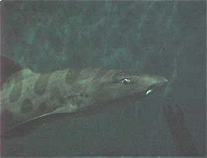|
|
|
|
Leopard Sharks in Captivity Here we are going to meet the Milwaukee County Zoo's 2 female leopard sharks. I am studying this particular species of shark in preparation for the 2 we are going to be adding to our tide pool at the store. The 2 at the zoo are much larger than the "pups" we plan to have at the store. Because of the mixture of other large and poisonous fish in the zoo aquarium, the sharks are not hand fed or tame in any way. My goal at the store is to hand feed our sharks whenever possible, to make it easier for me to educate the public and the school groups that visit us. Below is just the beginnings of the research I am going to do over the next 3 weeks, and hopefully ongoing for as long as the sharks are at the store, or until I'm no longer able to work there with them. (I don't see that ever happening, lol) I have spent 3 days in the past week at the zoo, spending hours in front of the aquariums, taking many many pictures, and making any notes that I can think to make. I had a short time today with one of the zookeepers at the zoo aquarium, and have scheduled another, longer, visit with him in 2 weeks....so I will be posting many more details after that visit. |
||

Notice the markings that are unique of the leopard shark. There are "saddle shaped" patterns all along it's back, with smaller "spots" along it's sides. The coloration appeared to be something of a gray/brown, with the markings in darker browns and black. The eyes are very "cat like", and the scales appeared to have a glossy sheen to them. It will be interesting to compare the look to the actual feel. There are 5 vents on each side, and small "holes" in a small pattern, about a dozen on each side, behind and just above the eye, which I am assuming at the moment are the spiracles. |
The underside of the leopard shark is solid and light in color. At the tip we can see the nostrils and then the mouth, which contains a lifetime supply of razor sharp teeth. The teeth of a shark grow in rows, one behind the other. The front row stands erect, while the subsequent rows lay flat behind them until they are needed. A shark can have from 5 - 20 rows of teeth in it's mouth, so I think I will be very careful when attempting to hand feed the pups when they come in. As we travel back further on the underside, we see a sleek, smooth, solid, light color, and nothing else significant. (other than the sheer beauty of the silhouette above us)
|
Here we can take a look at the finage of the leopard shark. The shark has more fins than we're used to seeing on our aquarium fish. There are 2 fins on top called dorsal fins, with the leopard shark having no horn, There are 2 fins low on the body, just behind the head, called pectoral fins. Behind the pectoral fins there is a pair of pelvic fins. Behind the pelvic fins, on the under side of the shark, is the anal fin. Last, but not least, is the ever so beautiful "tail" of the shark, called a caudal fin.
|